Financial Analysis of BAE Systems and Capital Structure Evaluation
VerifiedAdded on 2023/01/16
|14
|2550
|22
Report
AI Summary
This report provides a comprehensive financial analysis of BAE Systems, a UK-based aerospace, defense, and security company. It begins with an introduction to finance and its key aspects, including financial analysis, company valuation, and capital structure. The financial analysis section i...
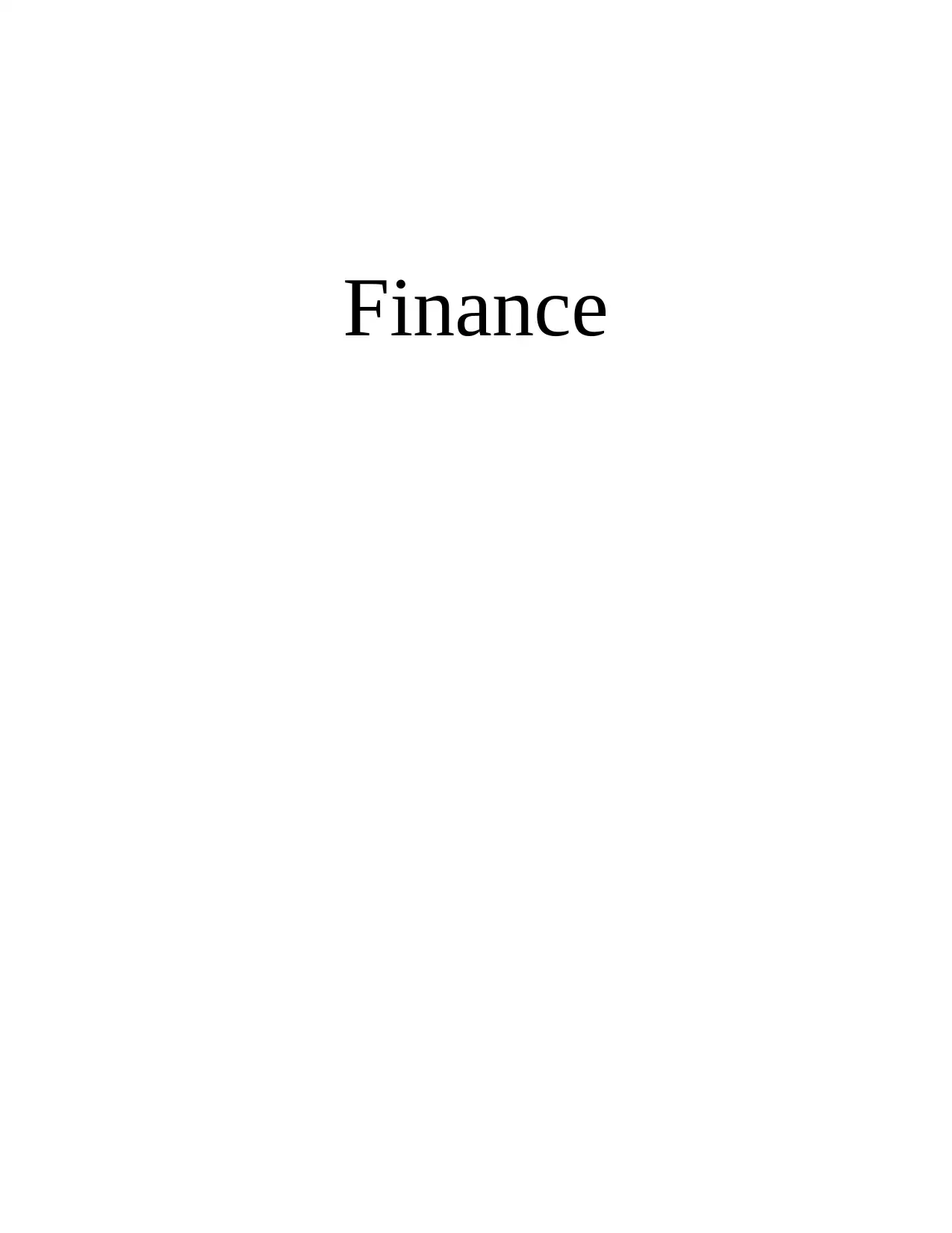
Finance
Paraphrase This Document
Need a fresh take? Get an instant paraphrase of this document with our AI Paraphraser
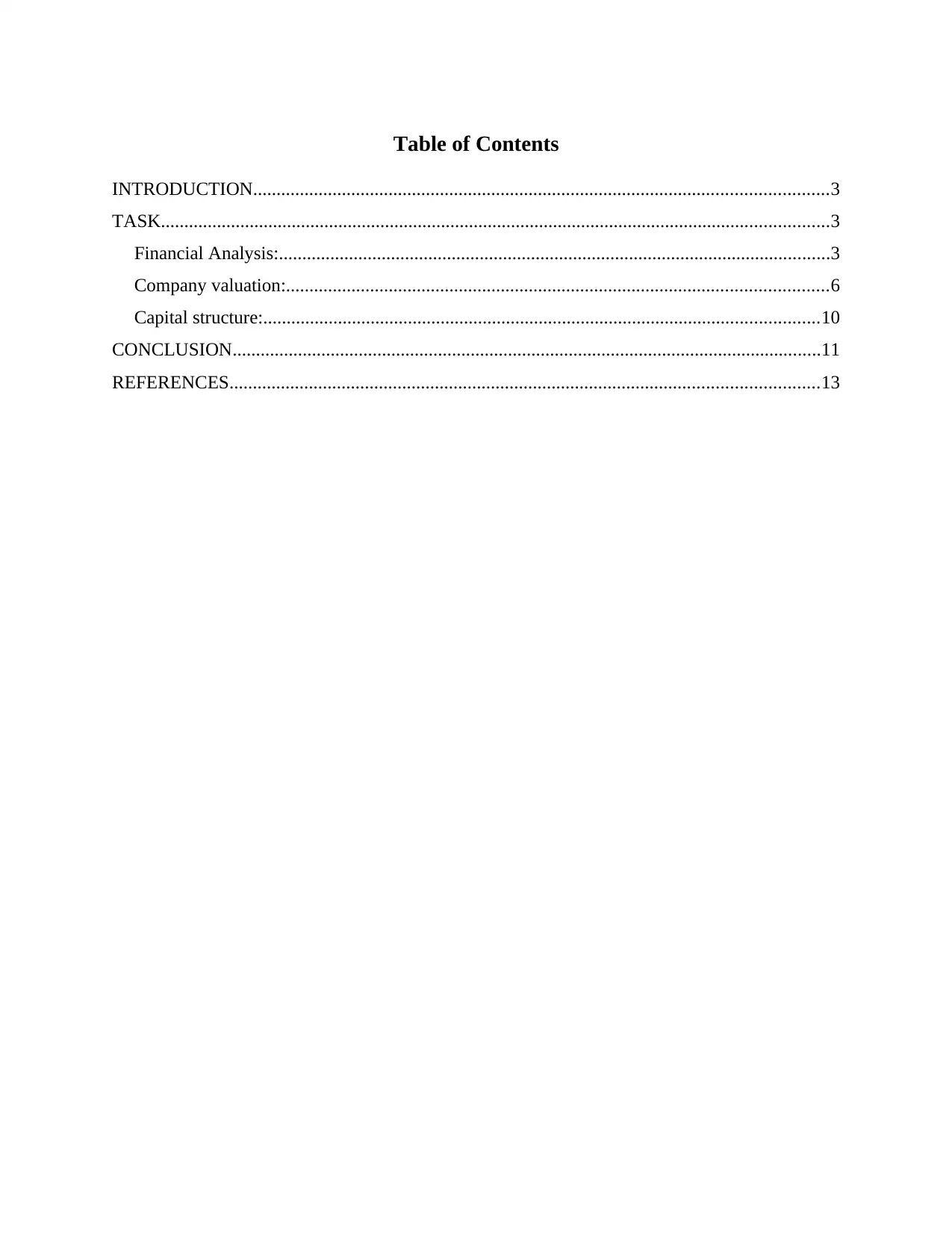
Table of Contents
INTRODUCTION...........................................................................................................................3
TASK...............................................................................................................................................3
Financial Analysis:......................................................................................................................3
Company valuation:....................................................................................................................6
Capital structure:.......................................................................................................................10
CONCLUSION..............................................................................................................................11
REFERENCES..............................................................................................................................13
INTRODUCTION...........................................................................................................................3
TASK...............................................................................................................................................3
Financial Analysis:......................................................................................................................3
Company valuation:....................................................................................................................6
Capital structure:.......................................................................................................................10
CONCLUSION..............................................................................................................................11
REFERENCES..............................................................................................................................13
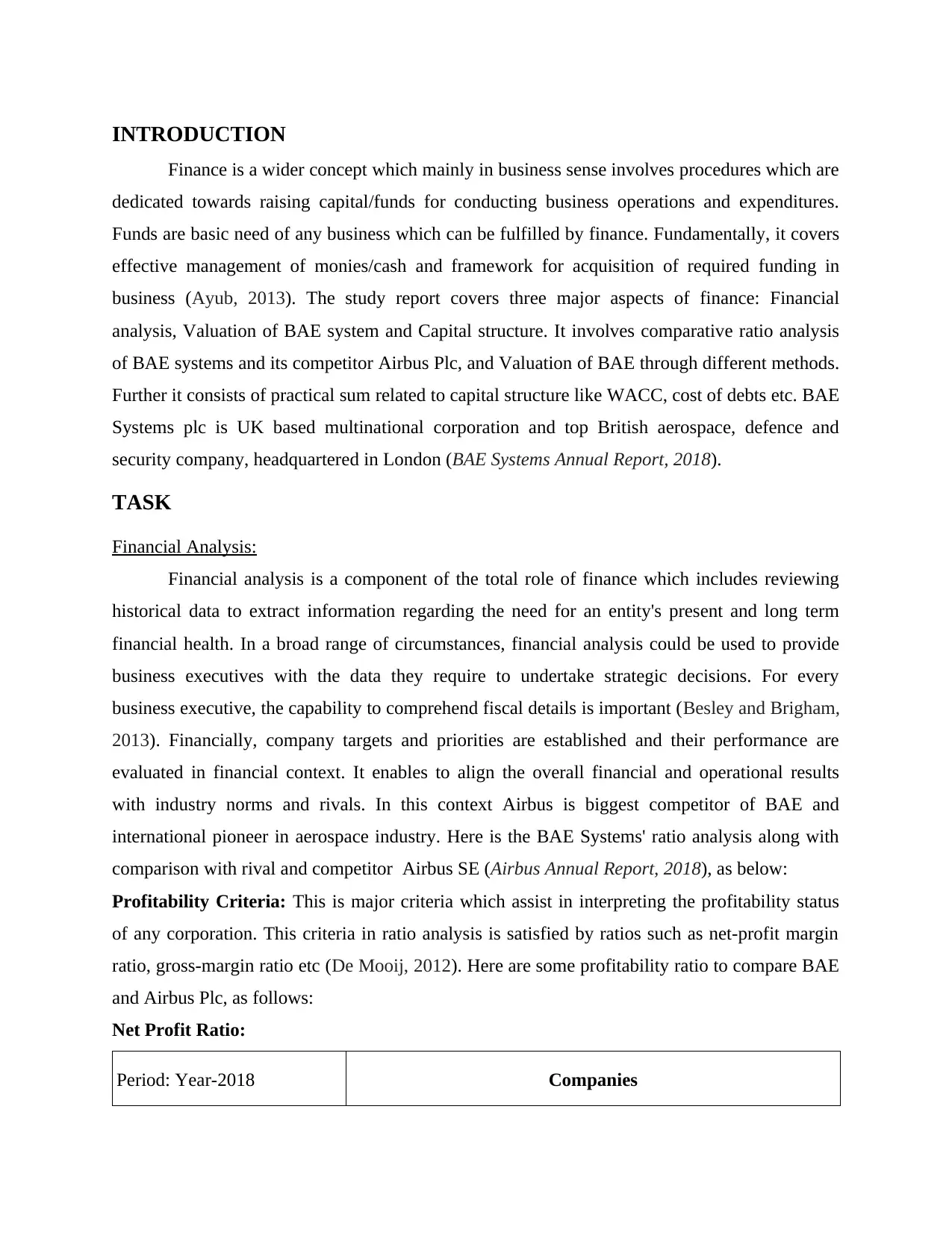
INTRODUCTION
Finance is a wider concept which mainly in business sense involves procedures which are
dedicated towards raising capital/funds for conducting business operations and expenditures.
Funds are basic need of any business which can be fulfilled by finance. Fundamentally, it covers
effective management of monies/cash and framework for acquisition of required funding in
business (Ayub, 2013). The study report covers three major aspects of finance: Financial
analysis, Valuation of BAE system and Capital structure. It involves comparative ratio analysis
of BAE systems and its competitor Airbus Plc, and Valuation of BAE through different methods.
Further it consists of practical sum related to capital structure like WACC, cost of debts etc. BAE
Systems plc is UK based multinational corporation and top British aerospace, defence and
security company, headquartered in London (BAE Systems Annual Report, 2018).
TASK
Financial Analysis:
Financial analysis is a component of the total role of finance which includes reviewing
historical data to extract information regarding the need for an entity's present and long term
financial health. In a broad range of circumstances, financial analysis could be used to provide
business executives with the data they require to undertake strategic decisions. For every
business executive, the capability to comprehend fiscal details is important (Besley and Brigham,
2013). Financially, company targets and priorities are established and their performance are
evaluated in financial context. It enables to align the overall financial and operational results
with industry norms and rivals. In this context Airbus is biggest competitor of BAE and
international pioneer in aerospace industry. Here is the BAE Systems' ratio analysis along with
comparison with rival and competitor Airbus SE (Airbus Annual Report, 2018), as below:
Profitability Criteria: This is major criteria which assist in interpreting the profitability status
of any corporation. This criteria in ratio analysis is satisfied by ratios such as net-profit margin
ratio, gross-margin ratio etc (De Mooij, 2012). Here are some profitability ratio to compare BAE
and Airbus Plc, as follows:
Net Profit Ratio:
Period: Year-2018 Companies
Finance is a wider concept which mainly in business sense involves procedures which are
dedicated towards raising capital/funds for conducting business operations and expenditures.
Funds are basic need of any business which can be fulfilled by finance. Fundamentally, it covers
effective management of monies/cash and framework for acquisition of required funding in
business (Ayub, 2013). The study report covers three major aspects of finance: Financial
analysis, Valuation of BAE system and Capital structure. It involves comparative ratio analysis
of BAE systems and its competitor Airbus Plc, and Valuation of BAE through different methods.
Further it consists of practical sum related to capital structure like WACC, cost of debts etc. BAE
Systems plc is UK based multinational corporation and top British aerospace, defence and
security company, headquartered in London (BAE Systems Annual Report, 2018).
TASK
Financial Analysis:
Financial analysis is a component of the total role of finance which includes reviewing
historical data to extract information regarding the need for an entity's present and long term
financial health. In a broad range of circumstances, financial analysis could be used to provide
business executives with the data they require to undertake strategic decisions. For every
business executive, the capability to comprehend fiscal details is important (Besley and Brigham,
2013). Financially, company targets and priorities are established and their performance are
evaluated in financial context. It enables to align the overall financial and operational results
with industry norms and rivals. In this context Airbus is biggest competitor of BAE and
international pioneer in aerospace industry. Here is the BAE Systems' ratio analysis along with
comparison with rival and competitor Airbus SE (Airbus Annual Report, 2018), as below:
Profitability Criteria: This is major criteria which assist in interpreting the profitability status
of any corporation. This criteria in ratio analysis is satisfied by ratios such as net-profit margin
ratio, gross-margin ratio etc (De Mooij, 2012). Here are some profitability ratio to compare BAE
and Airbus Plc, as follows:
Net Profit Ratio:
Period: Year-2018 Companies
⊘ This is a preview!⊘
Do you want full access?
Subscribe today to unlock all pages.

Trusted by 1+ million students worldwide
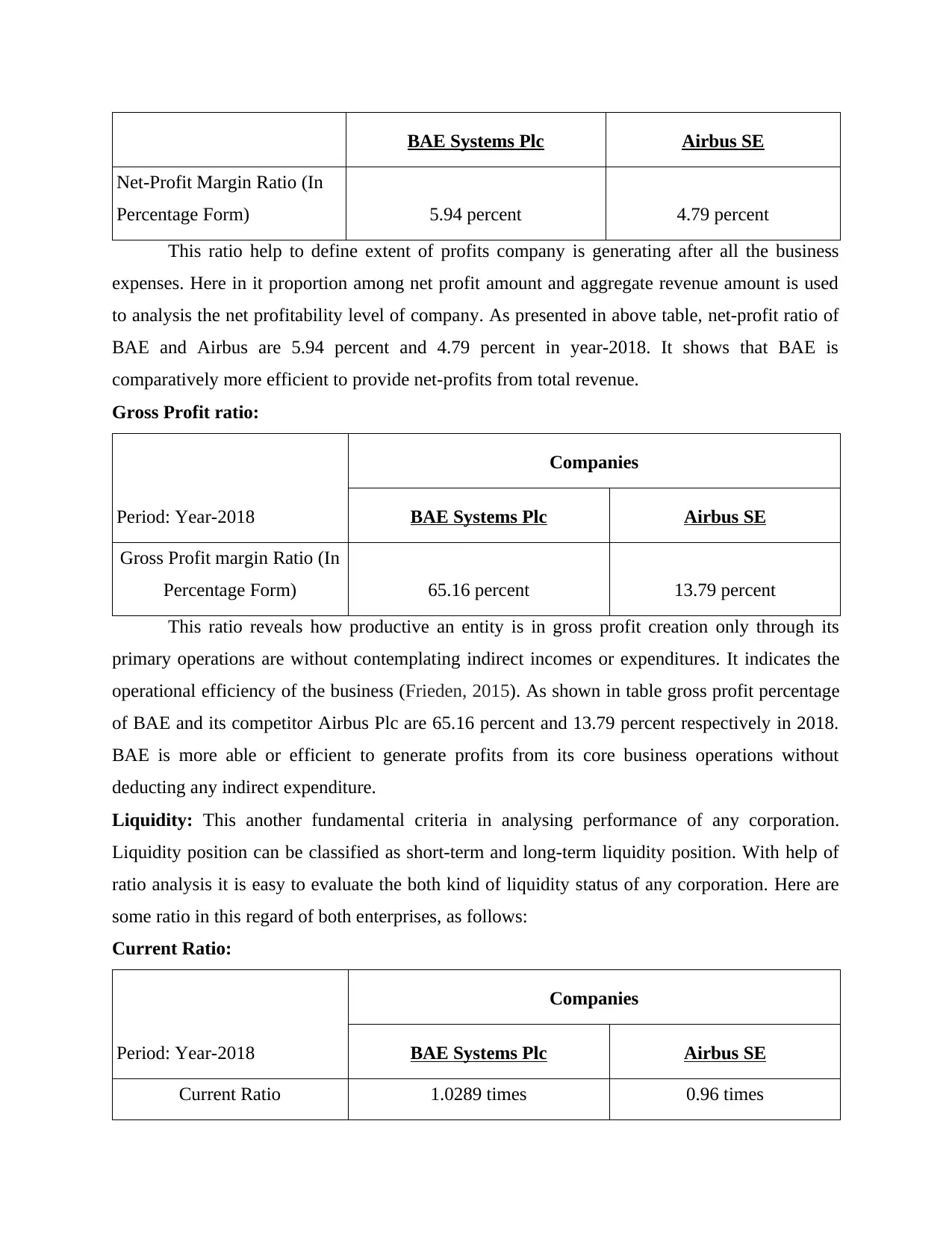
BAE Systems Plc Airbus SE
Net-Profit Margin Ratio (In
Percentage Form) 5.94 percent 4.79 percent
This ratio help to define extent of profits company is generating after all the business
expenses. Here in it proportion among net profit amount and aggregate revenue amount is used
to analysis the net profitability level of company. As presented in above table, net-profit ratio of
BAE and Airbus are 5.94 percent and 4.79 percent in year-2018. It shows that BAE is
comparatively more efficient to provide net-profits from total revenue.
Gross Profit ratio:
Period: Year-2018
Companies
BAE Systems Plc Airbus SE
Gross Profit margin Ratio (In
Percentage Form) 65.16 percent 13.79 percent
This ratio reveals how productive an entity is in gross profit creation only through its
primary operations are without contemplating indirect incomes or expenditures. It indicates the
operational efficiency of the business (Frieden, 2015). As shown in table gross profit percentage
of BAE and its competitor Airbus Plc are 65.16 percent and 13.79 percent respectively in 2018.
BAE is more able or efficient to generate profits from its core business operations without
deducting any indirect expenditure.
Liquidity: This another fundamental criteria in analysing performance of any corporation.
Liquidity position can be classified as short-term and long-term liquidity position. With help of
ratio analysis it is easy to evaluate the both kind of liquidity status of any corporation. Here are
some ratio in this regard of both enterprises, as follows:
Current Ratio:
Period: Year-2018
Companies
BAE Systems Plc Airbus SE
Current Ratio 1.0289 times 0.96 times
Net-Profit Margin Ratio (In
Percentage Form) 5.94 percent 4.79 percent
This ratio help to define extent of profits company is generating after all the business
expenses. Here in it proportion among net profit amount and aggregate revenue amount is used
to analysis the net profitability level of company. As presented in above table, net-profit ratio of
BAE and Airbus are 5.94 percent and 4.79 percent in year-2018. It shows that BAE is
comparatively more efficient to provide net-profits from total revenue.
Gross Profit ratio:
Period: Year-2018
Companies
BAE Systems Plc Airbus SE
Gross Profit margin Ratio (In
Percentage Form) 65.16 percent 13.79 percent
This ratio reveals how productive an entity is in gross profit creation only through its
primary operations are without contemplating indirect incomes or expenditures. It indicates the
operational efficiency of the business (Frieden, 2015). As shown in table gross profit percentage
of BAE and its competitor Airbus Plc are 65.16 percent and 13.79 percent respectively in 2018.
BAE is more able or efficient to generate profits from its core business operations without
deducting any indirect expenditure.
Liquidity: This another fundamental criteria in analysing performance of any corporation.
Liquidity position can be classified as short-term and long-term liquidity position. With help of
ratio analysis it is easy to evaluate the both kind of liquidity status of any corporation. Here are
some ratio in this regard of both enterprises, as follows:
Current Ratio:
Period: Year-2018
Companies
BAE Systems Plc Airbus SE
Current Ratio 1.0289 times 0.96 times
Paraphrase This Document
Need a fresh take? Get an instant paraphrase of this document with our AI Paraphraser

This ratio is major short-term liquidity measure which supports the evaluation of relation
among current assets as well as current-liabilities. Generally current ratio should be at least 2
times this shows current assets should be more than twice of the current-liabilities (Knorr Cetina
and Preda, 2012). Here in above table reflects that current ratios are 1.0289 and 0.96 respectively
of BAE Systems and Airbus Plc. Company BAE's current ratio is greater than Airbus SE, a
greater current ratio is indicator that company is more efficient to make payments of current-
liabilities by aggregate current assets. However there is requirement of making improvement in
current ratio and this is possible by controlling working capital specially trade receivable
collection and trade payable payments.
Debt to Equity Ratio:
Period: Year-2018
Companies
BAE Systems Airbus SE
Debt-equity Ratio 3.4620 times 10.85 times
This ratio determines the long-range liquidity position of enterprise. This is also a
leveraging multiplier that calculates all of the business's loans and liabilities weighted against the
overall net amount of stake-holder's equity funds balance. This figures to the economic viability
of the business and the status of long-term liquidity. For 2018, the debt-equity ratio of BAE
Systems is around 3.4620, while the debt-equity ratio of Airbus SE is around 10,58. A smaller
ratio suggests that the enterprise is financially solvent, which implies that BAE is comparatively
more financially solvent than Airbus SE. A larger debt-to-equity ratio than rivals suggest that
BAE is less volatile because it depends less on debt financing.
Investor Ratios: From investor's perspective it is a crucial ratio which shows how efficiently
company can provide returns to its equity shareholders. In involves those ratio which help to
define company's position in eyes of investors and shareholders (McLean and Zhao, 2014). Here
is major investor ratio which can help in understanding the status of both companies, as follows:
Return on Equity:
Companies
Period: Year-2018 BAE Systems Airbus SE
among current assets as well as current-liabilities. Generally current ratio should be at least 2
times this shows current assets should be more than twice of the current-liabilities (Knorr Cetina
and Preda, 2012). Here in above table reflects that current ratios are 1.0289 and 0.96 respectively
of BAE Systems and Airbus Plc. Company BAE's current ratio is greater than Airbus SE, a
greater current ratio is indicator that company is more efficient to make payments of current-
liabilities by aggregate current assets. However there is requirement of making improvement in
current ratio and this is possible by controlling working capital specially trade receivable
collection and trade payable payments.
Debt to Equity Ratio:
Period: Year-2018
Companies
BAE Systems Airbus SE
Debt-equity Ratio 3.4620 times 10.85 times
This ratio determines the long-range liquidity position of enterprise. This is also a
leveraging multiplier that calculates all of the business's loans and liabilities weighted against the
overall net amount of stake-holder's equity funds balance. This figures to the economic viability
of the business and the status of long-term liquidity. For 2018, the debt-equity ratio of BAE
Systems is around 3.4620, while the debt-equity ratio of Airbus SE is around 10,58. A smaller
ratio suggests that the enterprise is financially solvent, which implies that BAE is comparatively
more financially solvent than Airbus SE. A larger debt-to-equity ratio than rivals suggest that
BAE is less volatile because it depends less on debt financing.
Investor Ratios: From investor's perspective it is a crucial ratio which shows how efficiently
company can provide returns to its equity shareholders. In involves those ratio which help to
define company's position in eyes of investors and shareholders (McLean and Zhao, 2014). Here
is major investor ratio which can help in understanding the status of both companies, as follows:
Return on Equity:
Companies
Period: Year-2018 BAE Systems Airbus SE
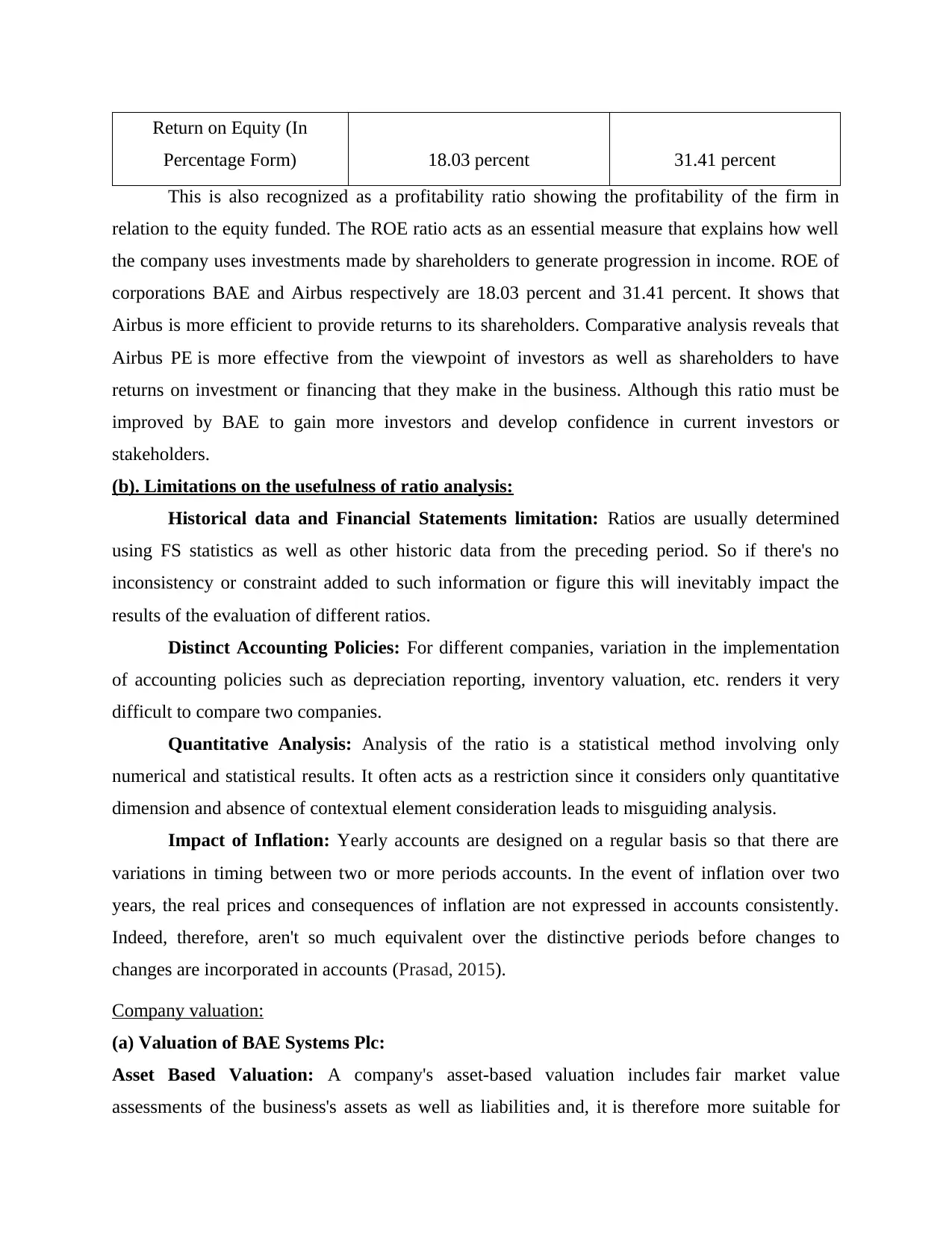
Return on Equity (In
Percentage Form) 18.03 percent 31.41 percent
This is also recognized as a profitability ratio showing the profitability of the firm in
relation to the equity funded. The ROE ratio acts as an essential measure that explains how well
the company uses investments made by shareholders to generate progression in income. ROE of
corporations BAE and Airbus respectively are 18.03 percent and 31.41 percent. It shows that
Airbus is more efficient to provide returns to its shareholders. Comparative analysis reveals that
Airbus PE is more effective from the viewpoint of investors as well as shareholders to have
returns on investment or financing that they make in the business. Although this ratio must be
improved by BAE to gain more investors and develop confidence in current investors or
stakeholders.
(b). Limitations on the usefulness of ratio analysis:
Historical data and Financial Statements limitation: Ratios are usually determined
using FS statistics as well as other historic data from the preceding period. So if there's no
inconsistency or constraint added to such information or figure this will inevitably impact the
results of the evaluation of different ratios.
Distinct Accounting Policies: For different companies, variation in the implementation
of accounting policies such as depreciation reporting, inventory valuation, etc. renders it very
difficult to compare two companies.
Quantitative Analysis: Analysis of the ratio is a statistical method involving only
numerical and statistical results. It often acts as a restriction since it considers only quantitative
dimension and absence of contextual element consideration leads to misguiding analysis.
Impact of Inflation: Yearly accounts are designed on a regular basis so that there are
variations in timing between two or more periods accounts. In the event of inflation over two
years, the real prices and consequences of inflation are not expressed in accounts consistently.
Indeed, therefore, aren't so much equivalent over the distinctive periods before changes to
changes are incorporated in accounts (Prasad, 2015).
Company valuation:
(a) Valuation of BAE Systems Plc:
Asset Based Valuation: A company's asset-based valuation includes fair market value
assessments of the business's assets as well as liabilities and, it is therefore more suitable for
Percentage Form) 18.03 percent 31.41 percent
This is also recognized as a profitability ratio showing the profitability of the firm in
relation to the equity funded. The ROE ratio acts as an essential measure that explains how well
the company uses investments made by shareholders to generate progression in income. ROE of
corporations BAE and Airbus respectively are 18.03 percent and 31.41 percent. It shows that
Airbus is more efficient to provide returns to its shareholders. Comparative analysis reveals that
Airbus PE is more effective from the viewpoint of investors as well as shareholders to have
returns on investment or financing that they make in the business. Although this ratio must be
improved by BAE to gain more investors and develop confidence in current investors or
stakeholders.
(b). Limitations on the usefulness of ratio analysis:
Historical data and Financial Statements limitation: Ratios are usually determined
using FS statistics as well as other historic data from the preceding period. So if there's no
inconsistency or constraint added to such information or figure this will inevitably impact the
results of the evaluation of different ratios.
Distinct Accounting Policies: For different companies, variation in the implementation
of accounting policies such as depreciation reporting, inventory valuation, etc. renders it very
difficult to compare two companies.
Quantitative Analysis: Analysis of the ratio is a statistical method involving only
numerical and statistical results. It often acts as a restriction since it considers only quantitative
dimension and absence of contextual element consideration leads to misguiding analysis.
Impact of Inflation: Yearly accounts are designed on a regular basis so that there are
variations in timing between two or more periods accounts. In the event of inflation over two
years, the real prices and consequences of inflation are not expressed in accounts consistently.
Indeed, therefore, aren't so much equivalent over the distinctive periods before changes to
changes are incorporated in accounts (Prasad, 2015).
Company valuation:
(a) Valuation of BAE Systems Plc:
Asset Based Valuation: A company's asset-based valuation includes fair market value
assessments of the business's assets as well as liabilities and, it is therefore more suitable for
⊘ This is a preview!⊘
Do you want full access?
Subscribe today to unlock all pages.

Trusted by 1+ million students worldwide
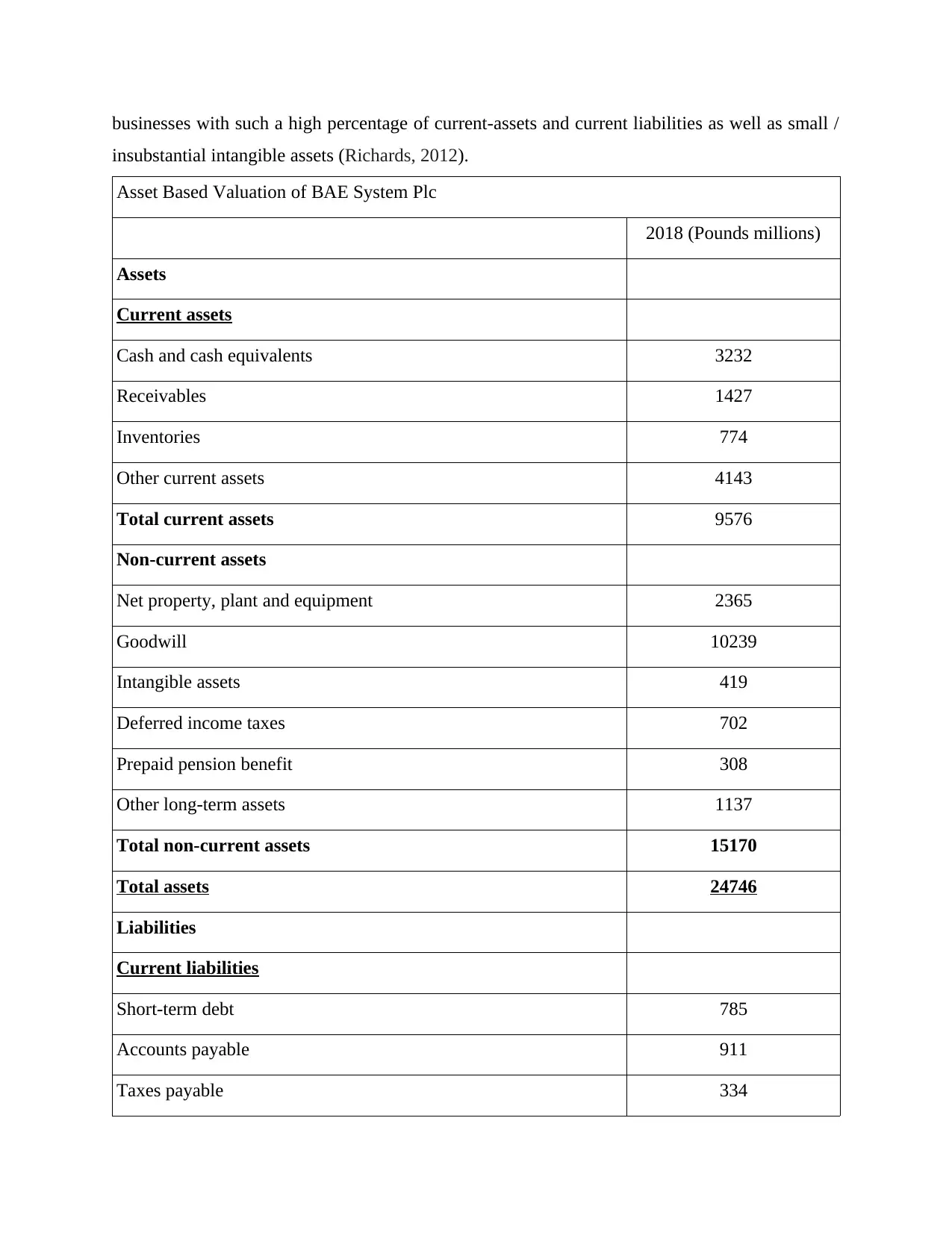
businesses with such a high percentage of current-assets and current liabilities as well as small /
insubstantial intangible assets (Richards, 2012).
Asset Based Valuation of BAE System Plc
2018 (Pounds millions)
Assets
Current assets
Cash and cash equivalents 3232
Receivables 1427
Inventories 774
Other current assets 4143
Total current assets 9576
Non-current assets
Net property, plant and equipment 2365
Goodwill 10239
Intangible assets 419
Deferred income taxes 702
Prepaid pension benefit 308
Other long-term assets 1137
Total non-current assets 15170
Total assets 24746
Liabilities
Current liabilities
Short-term debt 785
Accounts payable 911
Taxes payable 334
insubstantial intangible assets (Richards, 2012).
Asset Based Valuation of BAE System Plc
2018 (Pounds millions)
Assets
Current assets
Cash and cash equivalents 3232
Receivables 1427
Inventories 774
Other current assets 4143
Total current assets 9576
Non-current assets
Net property, plant and equipment 2365
Goodwill 10239
Intangible assets 419
Deferred income taxes 702
Prepaid pension benefit 308
Other long-term assets 1137
Total non-current assets 15170
Total assets 24746
Liabilities
Current liabilities
Short-term debt 785
Accounts payable 911
Taxes payable 334
Paraphrase This Document
Need a fresh take? Get an instant paraphrase of this document with our AI Paraphraser
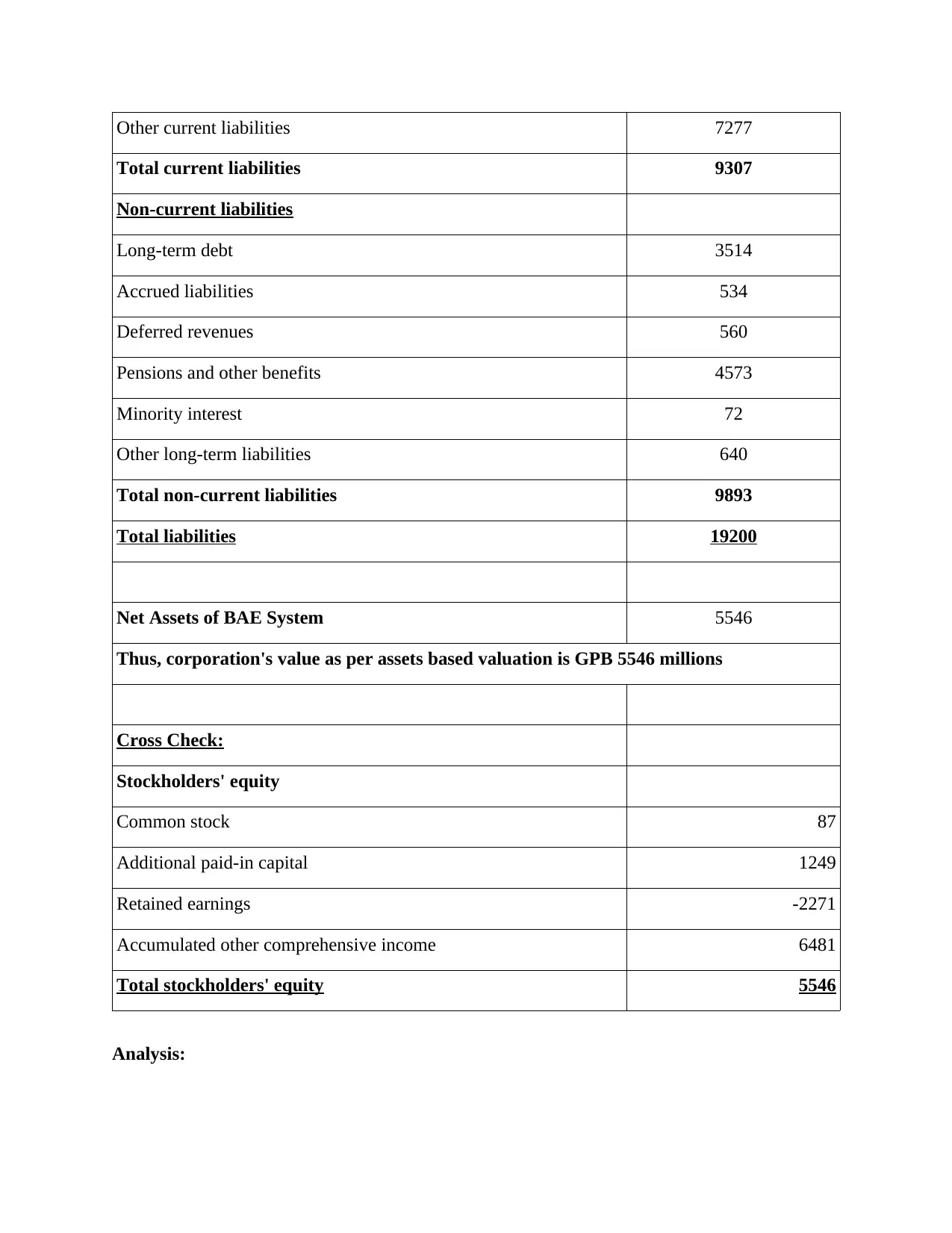
Other current liabilities 7277
Total current liabilities 9307
Non-current liabilities
Long-term debt 3514
Accrued liabilities 534
Deferred revenues 560
Pensions and other benefits 4573
Minority interest 72
Other long-term liabilities 640
Total non-current liabilities 9893
Total liabilities 19200
Net Assets of BAE System 5546
Thus, corporation's value as per assets based valuation is GPB 5546 millions
Cross Check:
Stockholders' equity
Common stock 87
Additional paid-in capital 1249
Retained earnings -2271
Accumulated other comprehensive income 6481
Total stockholders' equity 5546
Analysis:
Total current liabilities 9307
Non-current liabilities
Long-term debt 3514
Accrued liabilities 534
Deferred revenues 560
Pensions and other benefits 4573
Minority interest 72
Other long-term liabilities 640
Total non-current liabilities 9893
Total liabilities 19200
Net Assets of BAE System 5546
Thus, corporation's value as per assets based valuation is GPB 5546 millions
Cross Check:
Stockholders' equity
Common stock 87
Additional paid-in capital 1249
Retained earnings -2271
Accumulated other comprehensive income 6481
Total stockholders' equity 5546
Analysis:
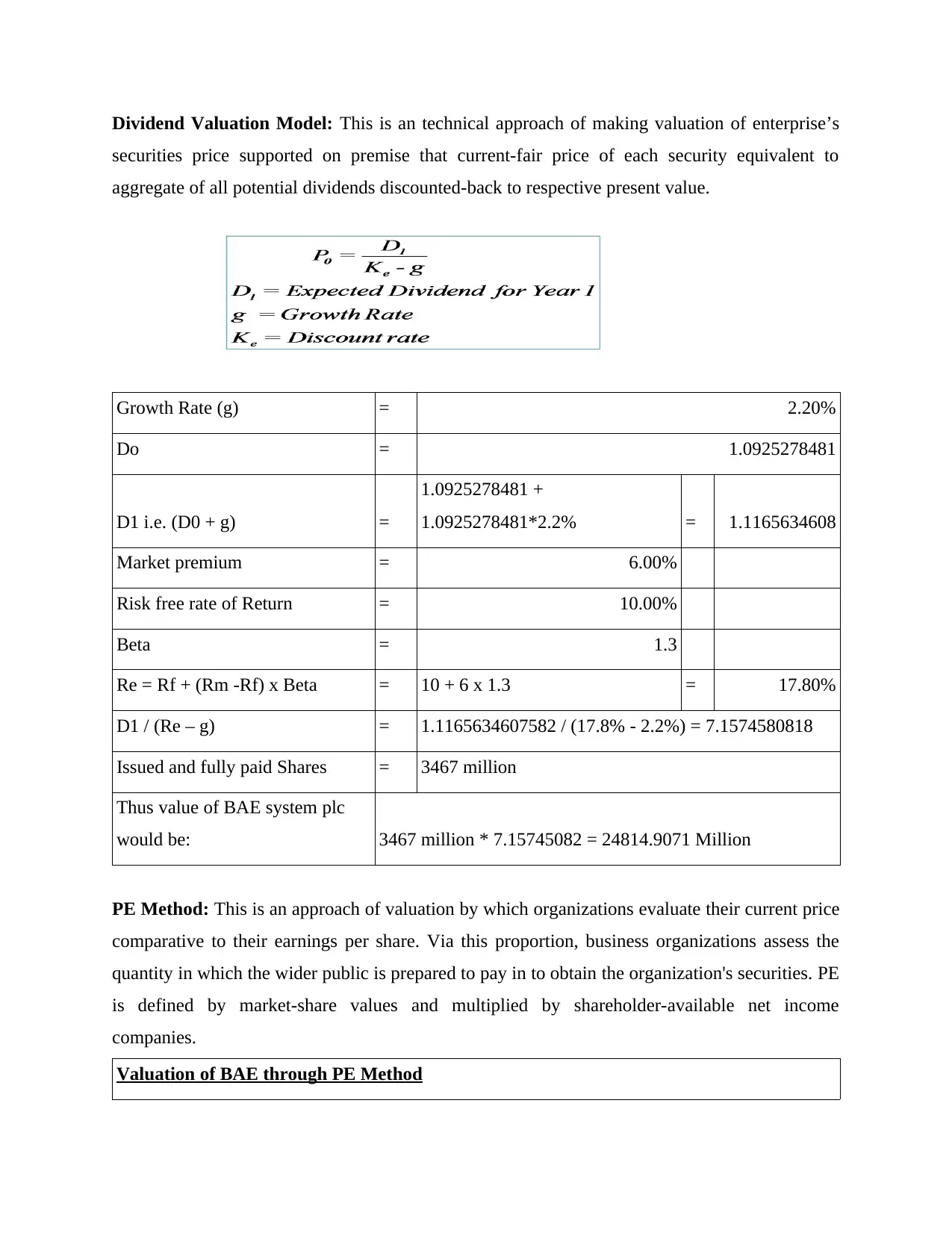
Dividend Valuation Model: This is an technical approach of making valuation of enterprise’s
securities price supported on premise that current-fair price of each security equivalent to
aggregate of all potential dividends discounted-back to respective present value.
Growth Rate (g) = 2.20%
Do = 1.0925278481
D1 i.e. (D0 + g) =
1.0925278481 +
1.0925278481*2.2% = 1.1165634608
Market premium = 6.00%
Risk free rate of Return = 10.00%
Beta = 1.3
Re = Rf + (Rm -Rf) x Beta = 10 + 6 x 1.3 = 17.80%
D1 / (Re – g) = 1.1165634607582 / (17.8% - 2.2%) = 7.1574580818
Issued and fully paid Shares = 3467 million
Thus value of BAE system plc
would be: 3467 million * 7.15745082 = 24814.9071 Million
PE Method: This is an approach of valuation by which organizations evaluate their current price
comparative to their earnings per share. Via this proportion, business organizations assess the
quantity in which the wider public is prepared to pay in to obtain the organization's securities. PE
is defined by market-share values and multiplied by shareholder-available net income
companies.
Valuation of BAE through PE Method
securities price supported on premise that current-fair price of each security equivalent to
aggregate of all potential dividends discounted-back to respective present value.
Growth Rate (g) = 2.20%
Do = 1.0925278481
D1 i.e. (D0 + g) =
1.0925278481 +
1.0925278481*2.2% = 1.1165634608
Market premium = 6.00%
Risk free rate of Return = 10.00%
Beta = 1.3
Re = Rf + (Rm -Rf) x Beta = 10 + 6 x 1.3 = 17.80%
D1 / (Re – g) = 1.1165634607582 / (17.8% - 2.2%) = 7.1574580818
Issued and fully paid Shares = 3467 million
Thus value of BAE system plc
would be: 3467 million * 7.15745082 = 24814.9071 Million
PE Method: This is an approach of valuation by which organizations evaluate their current price
comparative to their earnings per share. Via this proportion, business organizations assess the
quantity in which the wider public is prepared to pay in to obtain the organization's securities. PE
is defined by market-share values and multiplied by shareholder-available net income
companies.
Valuation of BAE through PE Method
⊘ This is a preview!⊘
Do you want full access?
Subscribe today to unlock all pages.

Trusted by 1+ million students worldwide
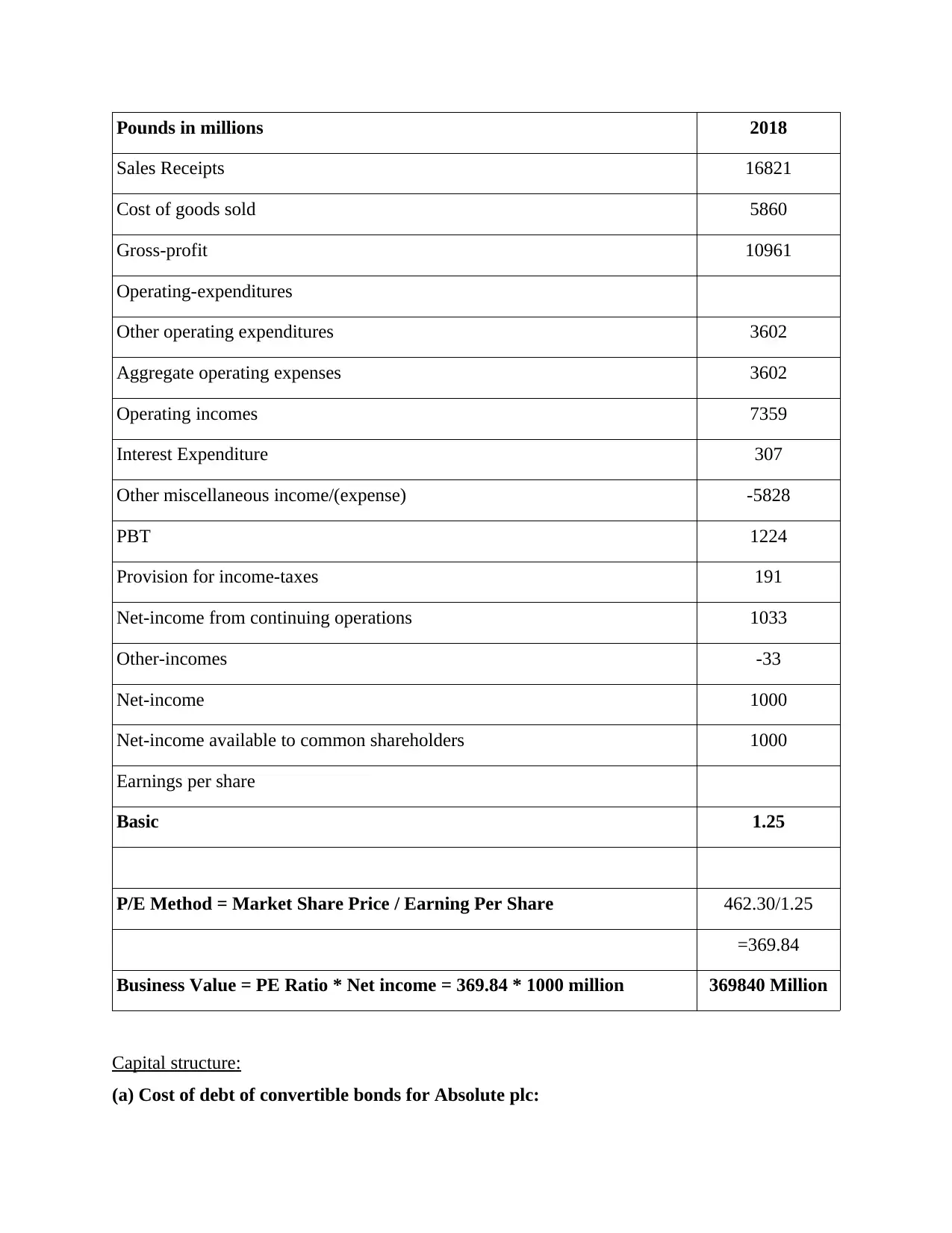
Pounds in millions 2018
Sales Receipts 16821
Cost of goods sold 5860
Gross-profit 10961
Operating-expenditures
Other operating expenditures 3602
Aggregate operating expenses 3602
Operating incomes 7359
Interest Expenditure 307
Other miscellaneous income/(expense) -5828
PBT 1224
Provision for income-taxes 191
Net-income from continuing operations 1033
Other-incomes -33
Net-income 1000
Net-income available to common shareholders 1000
Earnings per share
Basic 1.25
P/E Method = Market Share Price / Earning Per Share 462.30/1.25
=369.84
Business Value = PE Ratio * Net income = 369.84 * 1000 million 369840 Million
Capital structure:
(a) Cost of debt of convertible bonds for Absolute plc:
Sales Receipts 16821
Cost of goods sold 5860
Gross-profit 10961
Operating-expenditures
Other operating expenditures 3602
Aggregate operating expenses 3602
Operating incomes 7359
Interest Expenditure 307
Other miscellaneous income/(expense) -5828
PBT 1224
Provision for income-taxes 191
Net-income from continuing operations 1033
Other-incomes -33
Net-income 1000
Net-income available to common shareholders 1000
Earnings per share
Basic 1.25
P/E Method = Market Share Price / Earning Per Share 462.30/1.25
=369.84
Business Value = PE Ratio * Net income = 369.84 * 1000 million 369840 Million
Capital structure:
(a) Cost of debt of convertible bonds for Absolute plc:
Paraphrase This Document
Need a fresh take? Get an instant paraphrase of this document with our AI Paraphraser
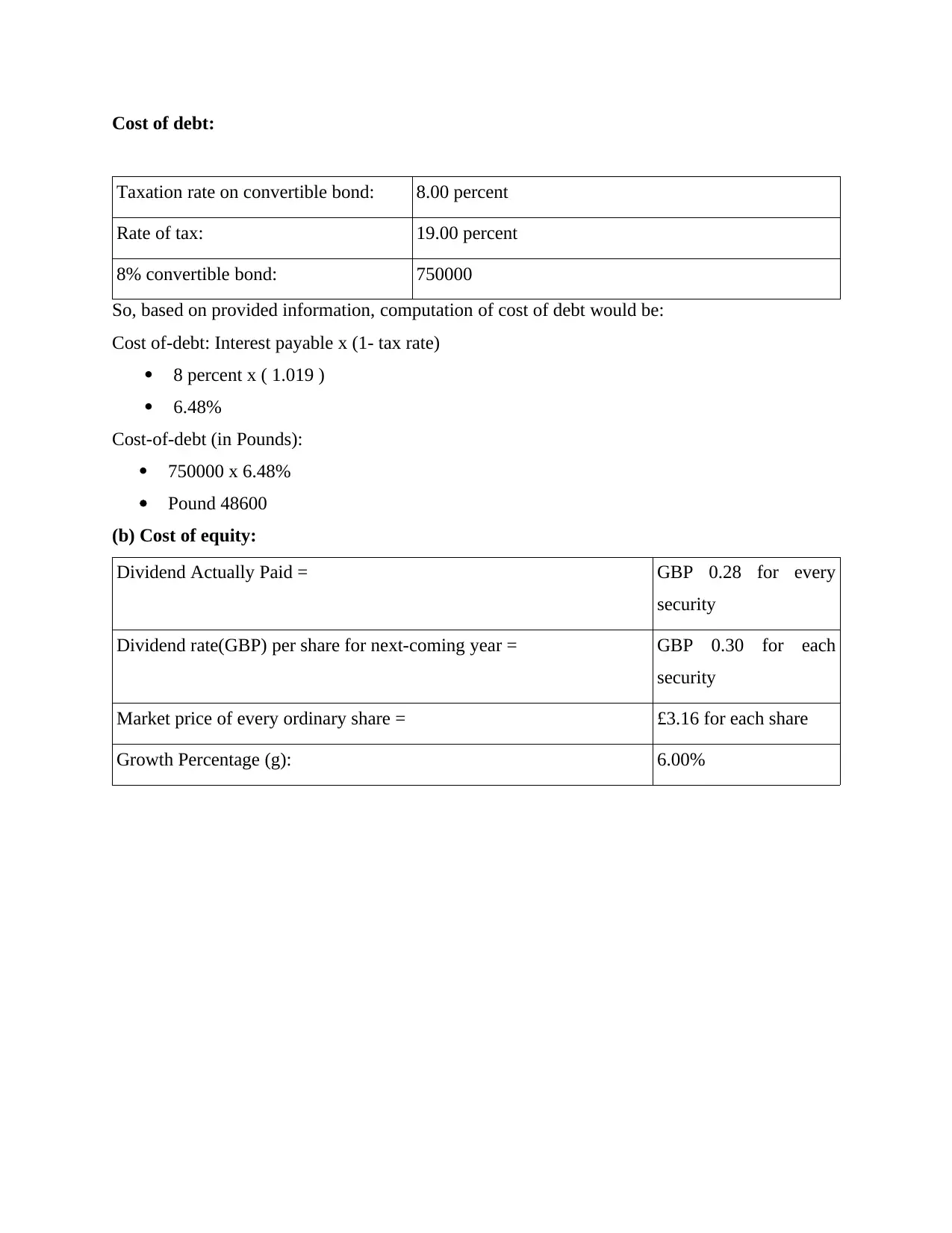
Cost of debt:
Taxation rate on convertible bond: 8.00 percent
Rate of tax: 19.00 percent
8% convertible bond: 750000
So, based on provided information, computation of cost of debt would be:
Cost of-debt: Interest payable x (1- tax rate)
8 percent x ( 1.019 )
6.48%
Cost-of-debt (in Pounds):
750000 x 6.48%
Pound 48600
(b) Cost of equity:
Dividend Actually Paid = GBP 0.28 for every
security
Dividend rate(GBP) per share for next-coming year = GBP 0.30 for each
security
Market price of every ordinary share = £3.16 for each share
Growth Percentage (g): 6.00%
Taxation rate on convertible bond: 8.00 percent
Rate of tax: 19.00 percent
8% convertible bond: 750000
So, based on provided information, computation of cost of debt would be:
Cost of-debt: Interest payable x (1- tax rate)
8 percent x ( 1.019 )
6.48%
Cost-of-debt (in Pounds):
750000 x 6.48%
Pound 48600
(b) Cost of equity:
Dividend Actually Paid = GBP 0.28 for every
security
Dividend rate(GBP) per share for next-coming year = GBP 0.30 for each
security
Market price of every ordinary share = £3.16 for each share
Growth Percentage (g): 6.00%
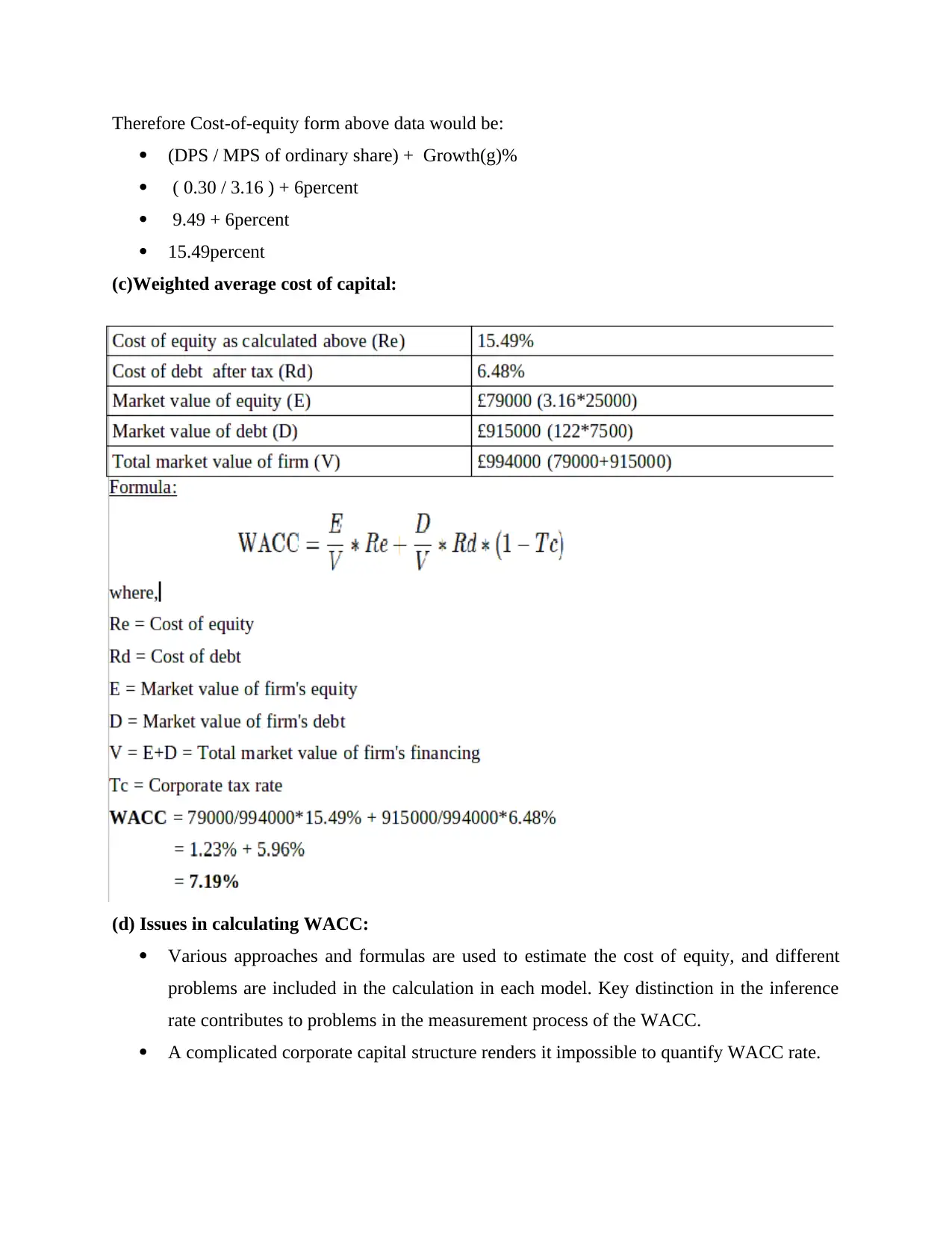
Therefore Cost-of-equity form above data would be:
(DPS / MPS of ordinary share) + Growth(g)%
( 0.30 / 3.16 ) + 6percent
9.49 + 6percent
15.49percent
(c)Weighted average cost of capital:
(d) Issues in calculating WACC:
Various approaches and formulas are used to estimate the cost of equity, and different
problems are included in the calculation in each model. Key distinction in the inference
rate contributes to problems in the measurement process of the WACC.
A complicated corporate capital structure renders it impossible to quantify WACC rate.
(DPS / MPS of ordinary share) + Growth(g)%
( 0.30 / 3.16 ) + 6percent
9.49 + 6percent
15.49percent
(c)Weighted average cost of capital:
(d) Issues in calculating WACC:
Various approaches and formulas are used to estimate the cost of equity, and different
problems are included in the calculation in each model. Key distinction in the inference
rate contributes to problems in the measurement process of the WACC.
A complicated corporate capital structure renders it impossible to quantify WACC rate.
⊘ This is a preview!⊘
Do you want full access?
Subscribe today to unlock all pages.

Trusted by 1+ million students worldwide

WACC is an effective forward-looking indicator and estimates are focused not even on
past returns on potential returns. Thus in equity market valuation, therefore, the book
value is often not regarded (Wilson, 2012).
CONCLUSION
From above report it has been articulated that Finance is a wider term that covers all the
significant processes and operations related to managing funds and monies. Through different
forms of analysis and evaluation managers can compare the performance of business with its
rival firms. Finance field also covers multiple techniques for valuation of business like PE
model, asset based valuation, dividend based valuation model etc.
past returns on potential returns. Thus in equity market valuation, therefore, the book
value is often not regarded (Wilson, 2012).
CONCLUSION
From above report it has been articulated that Finance is a wider term that covers all the
significant processes and operations related to managing funds and monies. Through different
forms of analysis and evaluation managers can compare the performance of business with its
rival firms. Finance field also covers multiple techniques for valuation of business like PE
model, asset based valuation, dividend based valuation model etc.
Paraphrase This Document
Need a fresh take? Get an instant paraphrase of this document with our AI Paraphraser
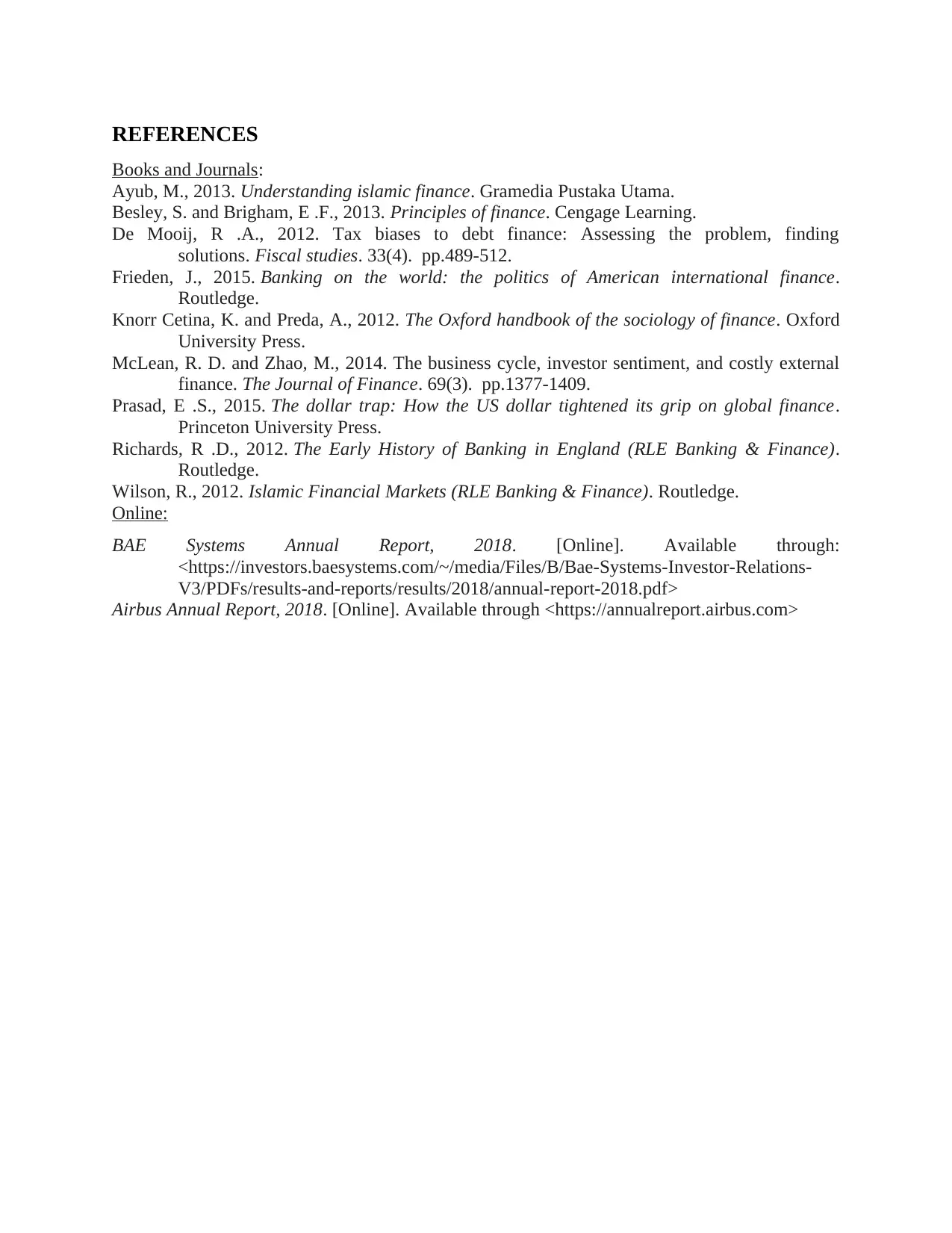
REFERENCES
Books and Journals:
Ayub, M., 2013. Understanding islamic finance. Gramedia Pustaka Utama.
Besley, S. and Brigham, E .F., 2013. Principles of finance. Cengage Learning.
De Mooij, R .A., 2012. Tax biases to debt finance: Assessing the problem, finding
solutions. Fiscal studies. 33(4). pp.489-512.
Frieden, J., 2015. Banking on the world: the politics of American international finance.
Routledge.
Knorr Cetina, K. and Preda, A., 2012. The Oxford handbook of the sociology of finance. Oxford
University Press.
McLean, R. D. and Zhao, M., 2014. The business cycle, investor sentiment, and costly external
finance. The Journal of Finance. 69(3). pp.1377-1409.
Prasad, E .S., 2015. The dollar trap: How the US dollar tightened its grip on global finance.
Princeton University Press.
Richards, R .D., 2012. The Early History of Banking in England (RLE Banking & Finance).
Routledge.
Wilson, R., 2012. Islamic Financial Markets (RLE Banking & Finance). Routledge.
Online:
BAE Systems Annual Report, 2018. [Online]. Available through:
<https://investors.baesystems.com/~/media/Files/B/Bae-Systems-Investor-Relations-
V3/PDFs/results-and-reports/results/2018/annual-report-2018.pdf>
Airbus Annual Report, 2018. [Online]. Available through <https://annualreport.airbus.com>
Books and Journals:
Ayub, M., 2013. Understanding islamic finance. Gramedia Pustaka Utama.
Besley, S. and Brigham, E .F., 2013. Principles of finance. Cengage Learning.
De Mooij, R .A., 2012. Tax biases to debt finance: Assessing the problem, finding
solutions. Fiscal studies. 33(4). pp.489-512.
Frieden, J., 2015. Banking on the world: the politics of American international finance.
Routledge.
Knorr Cetina, K. and Preda, A., 2012. The Oxford handbook of the sociology of finance. Oxford
University Press.
McLean, R. D. and Zhao, M., 2014. The business cycle, investor sentiment, and costly external
finance. The Journal of Finance. 69(3). pp.1377-1409.
Prasad, E .S., 2015. The dollar trap: How the US dollar tightened its grip on global finance.
Princeton University Press.
Richards, R .D., 2012. The Early History of Banking in England (RLE Banking & Finance).
Routledge.
Wilson, R., 2012. Islamic Financial Markets (RLE Banking & Finance). Routledge.
Online:
BAE Systems Annual Report, 2018. [Online]. Available through:
<https://investors.baesystems.com/~/media/Files/B/Bae-Systems-Investor-Relations-
V3/PDFs/results-and-reports/results/2018/annual-report-2018.pdf>
Airbus Annual Report, 2018. [Online]. Available through <https://annualreport.airbus.com>
1 out of 14
Related Documents
Your All-in-One AI-Powered Toolkit for Academic Success.
+13062052269
info@desklib.com
Available 24*7 on WhatsApp / Email
![[object Object]](/_next/static/media/star-bottom.7253800d.svg)
Unlock your academic potential
© 2024 | Zucol Services PVT LTD | All rights reserved.





